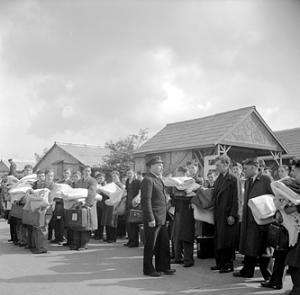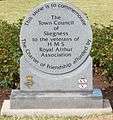HMS Royal Arthur (shore establishment)
 The Petty Officer in charge meets trainee Belgian sailors as they arrive at HMS Royal Arthur, Skegness, Lincolnshire. | |
| History | |
|---|---|
| Name: | HMS Royal Arthur |
| Commissioned: |
|
| Decommissioned: |
|
| Fate: |
|
| General characteristics | |
| Class and type: | Stone frigate |
HMS Royal Arthur was a shore establishment of the Royal Navy, initially at Ingoldmells near Skegness, and later at Corsham, Wiltshire. During the Second World War, the former holiday camp at Ingoldmells was used to mainly train 'Hostilities Only' (for the duration of the war only) communications branch ratings and officers (signalmen, telegraphists, coders and wireless operators).
Skegness
Shortly after the start of the Second World War, the Admiralty requisitioned the Butlins holiday camp at Ingoldmells near Skegness to be the first Royal Arthur stone frigate (land based establishment). It was commissioned as a training establishment on 22 September 1939.
It served throughout the Second World War as the central reception depot for new naval recruits after HMS Raleigh was transferred to the British Army in February 1944. Royal Arthur continued in service until being paid off in 1946.
Corsham
The establishment was recommissioned on 2 January 1947 in Westwells Road, Corsham as a leadership training establishment, and one of several assessment camps where new recruits were assessed, kitted out and sent to their various depots.[1]
The last recruits arrived on 31 October 1949 and on 15 March 1950 it ceased to be used for training National Service inductees and concentrated on leadership training of Petty Officers at the instigation of Lord Louis Mountbatten.[1][2] The name was then transferred to the recently paid off Camp Kingsmoor on 16 March 1950. The camp continued in service until the last trainees left on 11 December 1992 and personnel finally left on 5 March 1993.[3]
The site has suffered heavy vandalism since its abandonment and is now undergoing demolition for the building of a retirement village.[4]
Gallery
-

HMS Royal Arthur commemorative stone in Skegness
-
.jpg)
Butlins Skegness Memorial
-

HMS Royal Arthur Corsham site in 2011
References
Footnotes
- 1 2 "POST-WAR CHRONOLOGY OF ROYAL NAVY EVENTS, Part 1 - 1946-50". Retrieved 2008-08-15.
- ↑ "Correspondences between Lord Mountbatten and Gerhard Stamer and Werner Lott, 1946 - 1978". Retrieved 2008-08-15.
- ↑ "House of Commons Hansard Debates for 17 Jul 1991". HMSO. Retrieved 2008-08-04.
- ↑ "Morgan Sindall secures £18M retirement village on the site of the former HMS Royal Arthur navy training college in Corsham Wiltshire". BC Live. Builders Conference. 7 Apr 2014. Retrieved 3 June 2014.
Further reading
- Warlow, Ben, Shore Establishments of the Royal Navy, Liskeard : Maritime, 2000. ISBN 978-0-907771-73-9